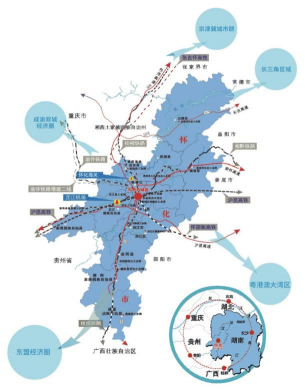
Unveiling Huaihua
Ø Area 27,600 square kilometers
Ø Total population 5.25 million
Ø Administrative division 12 counties, cities and districts as well as 1 administrative district within jurisdiction
|
Beijing-Tianjin-Hebei city cluster |
Yangtze River Delta region |
|
Chengdu-Chongqing economic zone |
Guangdong-Hong Kong-Macao Greater Bay Area |
|
ASEAN economic zone |
Yuanjiang River |
|
Zhangjiajie-Jishou-Huaihua High-speed Railway |
Shanghai-Kunming High-speed Railway |
|
Huaihua-Hengyang High-speed Railway |
Guizhou |
|
Hunan-Guizhou Railway |
Chongqing-Huaihua Railway |
|
Second Chongqing-Huaihua Railway |
Jiaozuo-Liuzhou Railway |
|
Baotou-Maoming Expressway |
Changchun-Jilin Expressway |
|
Loudi-Huaihua Expressway |
Shanghai-Kunming Expressway |
|
Zhangjiajie |
Changde |
|
Chongqing |
Yiyang |
|
Loudi |
Hongjiang |
|
Hongjiang Administrative District |
|
|
Shaoyang |
Huaihua |
|
Huaihua Customs District |
Huaihua Zhijiang Airport |
|
Guangxi Zhuang Autonomous Region |
Xiangxi Tujia and Miao Autonomous Prefecture |
|
Xinhuang Dong Autonomous County |
Jingzhou Miao and Dong Autonomous County |
|
Tongdao Dong Autonomous County |
Tongdao Industrial Park |
|
Zhijiang Dong Autonomous County |
Xupu County |
|
Yuanling County |
Chenxi County |
|
Huitong County |
Huitong Lianshan Industrial Park |
|
Huaihua Economic Development Zone |
Huaihua Industrial Park |
|
Hubei |
Chongqing |
|
Guizhou |
Hunan |
|
Guiyang |
Changsha |
|
Guangxi |
Guilin |
|
Yichang |
Yangtze River |
Geographical Location
Located in southwest Hunan Province, Huaihua is known as the “gateway to Guizhou and Yunnan” and has connections to various major Chinese cities. Covering an area of 27,600 square kilometers, it is the largest prefecture-level city in Hunan Province as well as the central city of the border areas of Hunan, Hubei, Chongqing, Guizhou and Guangxi. Huaihua has jurisdiction over 12 counties, cities and districts, one administrative district, one national high-tech industrial development zone, and one provincial economic development zone, with a total population of 5.25 million.
Three-dimensional transportation
At present, the three ordinary railway lines of the Shanghai-Kunming line, Jiaozuo-Liuzhou line and Chongqing-Huaihua line, as well as the three high-speed railway lines of the Shanghai-Kunming line, Huaihua-Hengyang line and Zhangjiajie-Jishou-Huaihua line intersect in the urban area of Huaihua City in a snowflake shape. The Huaihuaxi Marshalling Station emerges as the largest of its kind in southwest China. Huaihua Zhijiang Airport has flights to 11 cities, including Beijing, Shenzhen, Hangzhou and Kunming.
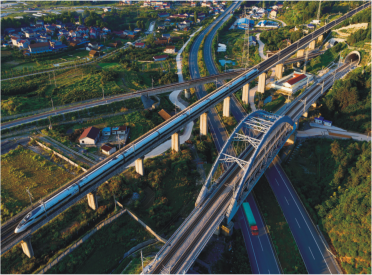
In the 1970s, the Hunan-Guizhou Railway and Jiaozuo-Liuzhou Railway were constructed, which gave birth to Huaihua City. At present, the three ordinary railway lines of the Shanghai-Kunming line, Jiaozuo-Liuzhou line and Chongqing-Huaihua line, as well as the three high-speed railway lines of the Shanghai-Kunming line, Huaihua-Hengyang line and Zhangjiajie-Jishou-Huaihua line intersect in the urban area of Huaihua City in a snowflake shape. The Huaihuaxi Marshalling Station emerges as the largest of its kind in southwest China. Huaihua Zhijiang Airport has flights to 10 cities, including Beijing, Shenzhen, Hangzhou and Kunming.
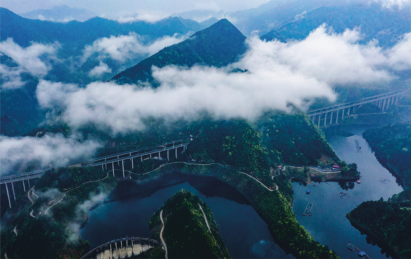
Xinhua-Xupu Expressway in Sanjiang Town, Xupu County
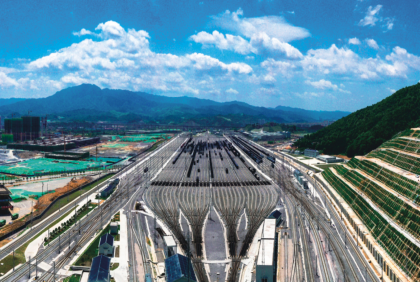
Huaihuaxi Marshalling Station
Natural Landscape
Ø Forest coverage rate 71.04%
Ø Average annual temperature 16.4°C
Ø Average annual sunshine hours 962-1,452 hours
Ø Average annual rainfall About 1,600 millimeters
Ø Tourist demonstration sites 27
Huaihua has a forest coverage rate of 71.04%, ranking first in Hunan Province. Boasting numerous natural oxygen zones, the city is one of the nine areas with good ecological conditions in China. It was once described as “a place of stunning beauty” by the prestigious writer Shen Congwen.

Xuefeng Mountain
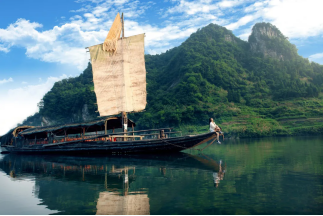
Youshui Gallery in Yuanling

Chuanyan Mountain in Xupu
Culture & History
On December 12, 1934, the person in charge of the CPC Central Committee held an emergency meeting in Tongdao, deciding that the Chinese Central Red Army would march westward to Guizhou. This event is known to history as “troop transfer in Tongdao”. General Secretary Xi Jinping, during his inspection tour in Hunan Province in September 2020, particularly mentioned that the “troop transfer in Tongdao” is a major historical event of the Party that took place in Hunan, the birthplace of a number of revolutionary forefathers with remarkable contributions, including Xiang Jingyu, Su Yu and Teng Daiyuan.



Xiang Jingyu Su Yu Teng Daiyuan

Tongdao Troop Transfer Memorial
On August 21, 1945, following the victory of the Anti-Japanese War, a surrender ceremony was held in Zhijiang of Huaihua, an event known to history as the “Zhijiang surrender”. The Zhijiang Surrender Memorial Hall is the only building in China commemorating the victory of the Anti-Japanese War. It is a testimony to and an important symbol of the victory of the war.
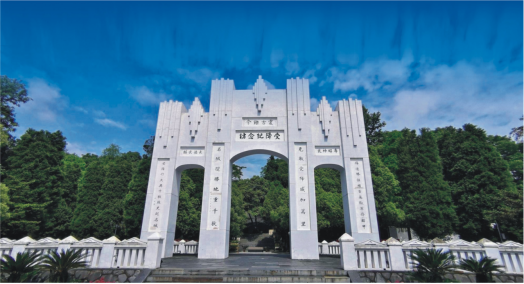
Zhijiang Surrender Memorial Hall
Yuan Longping, known as “father of hybrid rice”, worked and lived in Anjiang of Huaihua for 37 years. He successfully cultivated hybrid rice there, changing the world with one seed. The city is therefore called the “birthplace of hybrid rice”.
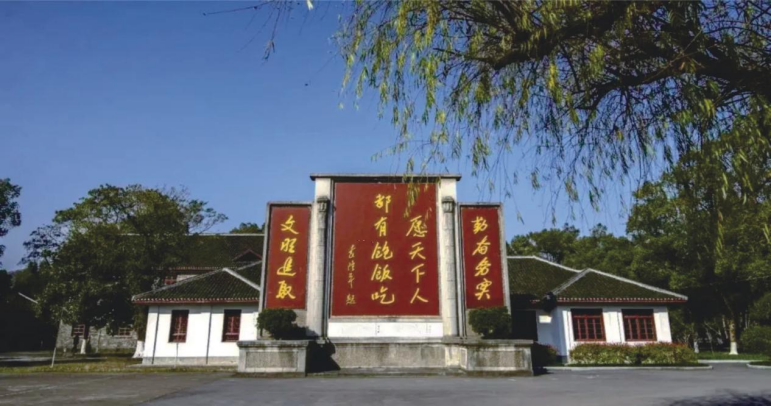
Site of the old Anjiang Agricultural School
The Gaomiao Ruins in Huaihua boasts a history of 7,800 years. The idioms “having five cartloads of books” and “storing books in the Eryou Mountain” find their origin there. Scholars such as Qu Yuan, Li Bai, Wang Changling and Wang Yangming wrote articles and poems there, which have been handed down from age to age. There are 50 ethnic minorities in Huaihua, including Dong, Miao, Tujia and Yao. With profound cultural heritage and ethnic custom, Huaihua is hailed as “a museum of ancient Chinese architecture” and “a cultural village of multiple ethnic groups”.
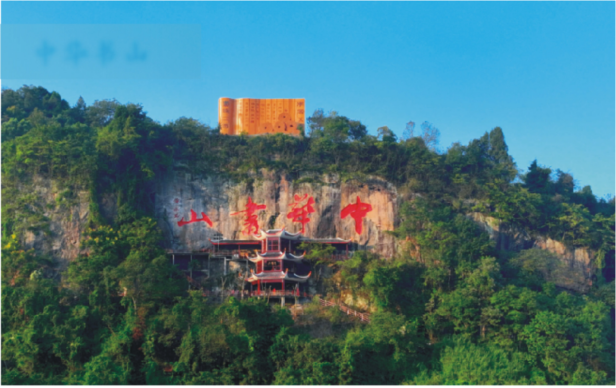
Zhonghuashu Mountain
(Translated by Professor Yu Jie)
